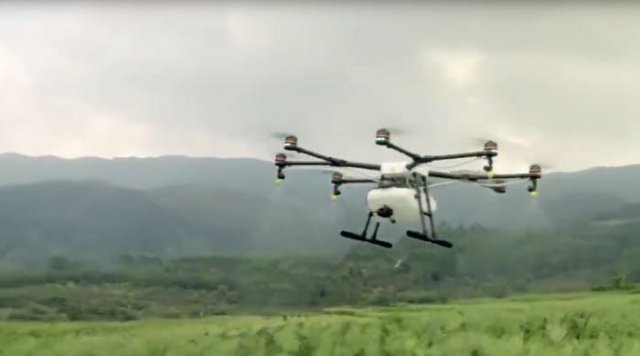China’s SZ DJI Technology Co. is setting its sights on the agriculture industry with the launch of a crop sprayer that will test whether farming is fertile ground for drone technology.
DJI has unveiled an eight-rotor drone priced at roughly $15,000 that is designed to spray pesticides on crops, a spokesman said. DJI said the drone, which has a 2.6-gallon spray tank and a typical takeoff weight of 49 pounds, can fly for about 12 minutes.
It can spray pesticides on seven to 10 acres of farmland per hour, depending on how much it needs to climb, descend or turn to follow the terrain.
The battery-powered DJI Agras MG-1 will be available first in China and South Korea, though the company didn’t specify exactly when it would go on sale. In China, DJI is taking preorders starting on Friday. The drone is expected to be available in other markets later, the company said.
Shenzhen-based DJI has found success selling drones to consumers and filmmakers since 2013, with revenue expected to exceed $1 billion this year.
The company, which is valued at roughly $8 billion based on its latest funding round, is now betting it can parlay that success into farming. Its push into the sector could open the way for other drone makers—or prove that agriculture isn’t the cornucopia for unmanned aircraft that some had hoped.
The Association of Unmanned Vehicle Systems International, the largest drone trade group, has touted farming as the biggest potential market for drones, by far. In a 2013 report, the Arlington, Va.-based group forecast that agriculture would account for 92% of an estimated $82 billion economic impact from commercial drones in the U.S. between 2015 and 2025.
But even as the commercial use of drones has taken off world-wide, agriculture is far from capturing such a large share of the market. Fewer companies are applying for U.S. Federal Aviation Administration approvals to use drones on farms than for activities such as filmmaking, mapping and industrial inspection, according to recent studies.
The FAA began regularly approving drones for commercial use in September 2014. Just 90 of the FAA’s first 1,355 approvals were for agriculture, according to Piper Jaffray Investment Research—well behind the 670 approvals for aerial filming. The FAA has approved most applications it receives.
Much of the promise for agricultural drones has been in their ability to collect large-scale aerial data on crops. The information helps farmers more precisely tend to their fields, adding or reducing irrigation or pesticides where necessary. So far, agricultural drones have failed to live up to their promise because giving farmers actionable data on their crops is far more complex than making a map or filming a movie, analysts said.
Commercial-drone maker Kespry Inc., based in Menlo Park, Calif., said it originally considered targeting agriculture as its top initial market, but ultimately decided on construction.
“To serve that market we need real expertise—agronomists who can combine the data with information on weather and local pests, and provide real recommendations,” said Kespry founder and Chief Executive Paul Doersch. “For us to scale it didn’t make sense.”
Despite the complexities, DJI isn’t the only drone maker betting on farming to diversify its revenue stream. Henri Seydoux, CEO of Paris-based Parrot SA, which has quickly captured the lower end of the consumer-drone market, said his company will collect data on 200,000 acres for farmers in France this year. Still, commercial drones earned Parrot just €5.6 million ($6 million) in the third quarter, compared with €44.4 million on consumer drones.
Agricultural drones “are at an early phase,” Mr. Seydoux said. “It’s true for all the commercial spaces. There is a lot of expectation but still not a big result.”
DJI is making a different bet on agriculture: spraying crops instead of inspecting them. In China, chemicals are often administered on foot by backpack-wielding workers. Drones would improve pesticide application on hilly or wet land that is difficult to access and would limit farmworkers’ exposure to chemicals, said Even Pay, a Beijing-based agriculture consultant who has studied Chinese farming methods.
Japanese farmers have used large gasoline-powered unmanned helicopters made by Yamaha Corp. since the early 1990s to spray their fields. Yamaha began selling the drones to farmers in South Korea in 2005.
The FAA in May approved the drone for limited use in the U.S., and the company is considering whether to introduce it in the country.
Analysts said DJI’s crop-spraying drone will likely struggle to win over Western farmers who generally tend to larger areas. Large U.S. farms have for decades used small planes that can carry hundreds of gallons of pesticide to spray their fields. The planes are efficient at covering large areas and relatively inexpensive to hire.
Robert Blair, an Idaho farmer and vice president of agriculture for commercial-drone company Measure LLC, said he is bullish on drones that collect data on crops but skeptical about crop-spraying drones like DJI’s that can carry only a few gallons of pesticide.
“It’s a niche market,” he said.
Source: Wall Street Journal

